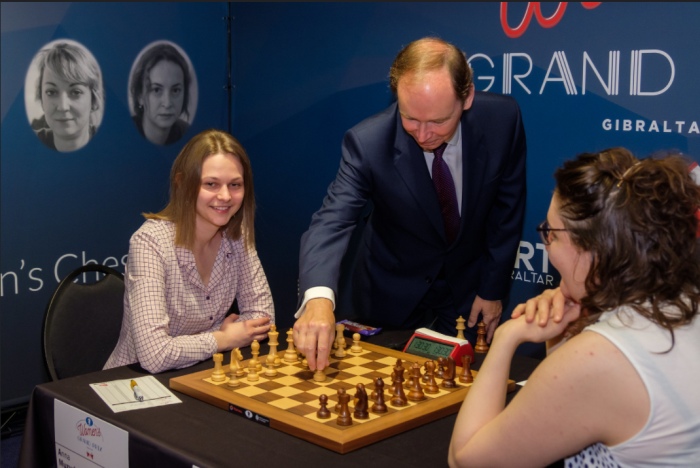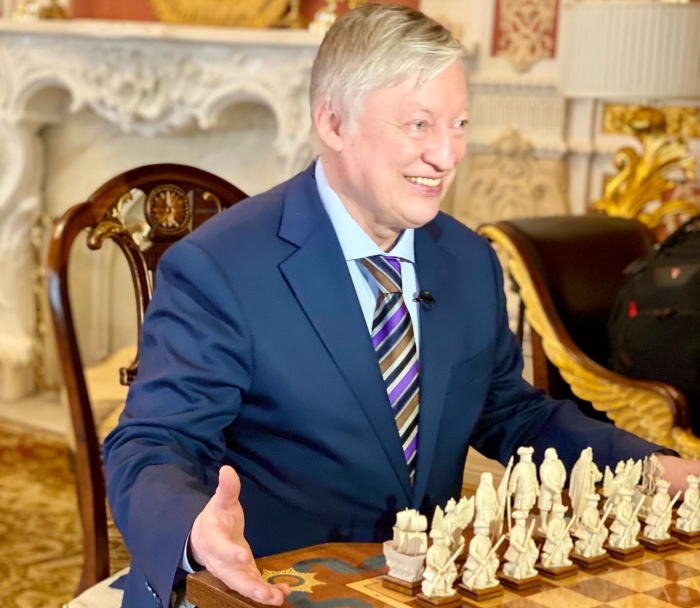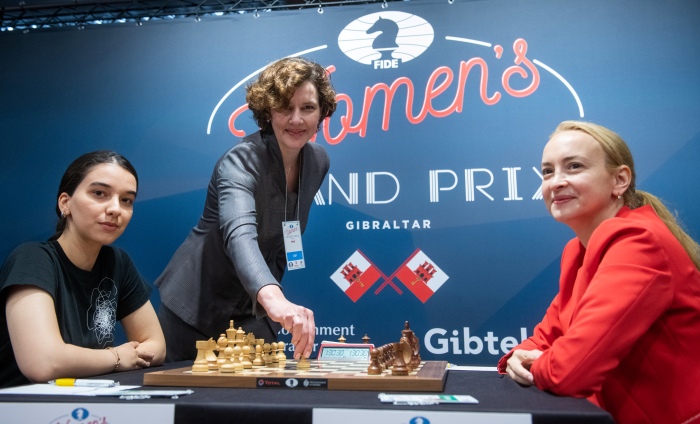Round 2: Blood on Board

Zhansaya Abdumalik, 21-year-old IM from Kazakhstan, is the sole leader on two points after round two of the Gibraltar leg of the FIDE Women’s Grand Prix was played at the Caleta Hotel on 23 May 2021. There are four players on 1½ points: Gunay Mammadzada (Azerbaijan), Mariya Muzychuk (Ukraine), Kateryna Lagno (Russia) and Antoaneta Stefanova (Bulgaria). The round was opened by the Governor of Gibraltar, His Excellency Sir David Steel, who expressed his gratitude to the players. “Thank you for coming so far to play in this magnificent tournament. Chess and Gibraltar go hand in hand: not quite as much, perhaps, as chess and Russia, chess and Azerbaijan, chess in Bulgaria, but quite close – we’re catching up. And you have come to Gibraltar at a time when Gibraltar is opening up after the pandemic and you have come, some of you a very long way, to be here.” Today we were also pleased to welcome back the founder and long-time organiser of the Gibraltar Chess Festival, Mr. Brian Callaghan, without whose untiring efforts major tournament chess would never have established a home in Gibraltar. The first result of the day was a draw between Anna Muzychuk and Nana Dzagnidze. This was an interesting skirmish in the Sveshnikov Sicilian, with the first decision of significance occurring on move 14 when Anna opted for 14 g4 to keep an eye on the light squares. Some cagey maneuvers followed, as two of the highest-rated players in the field jockeyed for superiority. The players safely neutralized each other’s attempts to win and by the time the queens were exchanged, the draw was in view. Thereafter there were terrifying quantities of blood spilled on the board, with no fewer than three players suffering a second defeat in two games. All five remaining games ended decisively, though, as in Round 1, not all ended in the result as first expected. Kateryna Lagno put herself in great danger of defeat as she unaccountably retreated her queen to its original square on move 12 on the white side of a Petroff defense, allowing a slow squeeze to be applied by Alina Kashlinskaya. It seemed improbable that Kateryna would get out of jail, but, as in round one, all Alina’s initial success went for naught as she snatched a hot pawn on the queenside, only to be shocked by Kateryna’s 21.Nxg7, underpinned by a sneaky tactic that would have won Black’s had the knight been captured. As a result, Black had to live with an ugly gash in her kingside pawn capture. Having blown a won position the day before against her other Russian colleague, poor Alina must have been suffering déjà vu and quickly subsided. Elisabeth Paehtz and Zhansaya Abdumalik went into round two with a win apiece but it was the young Kazakhstani player who proceeded to a perfect 2/2 start with another assured performance. The game began with an offbeat line of the Ruy Lopez (Berlin). Zhansaya’s original development of her a8 rook, via a6 to b6 to f6, and subtly undermining White’s queenside pawn structure, impressed commentator Nigel Short, and no doubt many others. Black snagged a pawn and deftly nursed her material and positional advantage through to another victory. One is beginning to wonder whether Zhansaya might have made a breakthrough in standard during the lull caused by the global pandemic, much as Aleksandra Goryachkina did a year or two back. Gunay Mammadzada versus Irina Bulmaga was some sort of indeterminate Sicilian which I would hesitate to give a more specific name to. Nor am I sure I’m qualified to give an opinion on who had the advantage out of the opening, despite having the inestimable advantage of hearing Gunay’s enthusiastic demonstration of the game at close quarters in the media center. Gunay seemed to relish the cut and thrust of the ensuing battle as both players descended into serious time trouble with only seconds left on their clocks. “It was more like a bullet game, then,” I observed to her and she agreed. Unsurprisingly, engines signalled wild swings of fortune during the period between move 23 and the time control. Black missed one golden opportunity with 26…Rh6 and once again the engine informs us that 33…Kb8 was a killer. Gunay herself felt sure without the benefit of engine analysis that 38…Qb5 represented another move that might have won for Black. Sadly for her, Irina missed all of these shots, and yet I cannot be sorry as otherwise I wouldn’t have been treated to Gunay’s entertaining exposition of this encounter. The game between Dinara Saduakassova and Mariya Muzychuk was a Catalan which followed a game between Deac and Gavrilescu from the Romanian Championship less than a month ago for some 15 moves, which I guess makes it a hot theory. It could also be described as one of those unusual Queen’s Gambits where Black hangs on grimly to the gambit pawn. Instructional manuals always used to be full of such games where Black is punished for such greediness, but whatever positional compensation Dinara gained for the pawn never quite materialized. Perhaps things mightn’t have been so bad had not Dinara retreated her knight to the a1 square where it looked decidedly unhappy. She then made the decision to hoover off the rooks to leave a most unpromising knight endgame, and she soon succumbed. The final game to finish was a slightly old-fashioned Caro-Kann between Antoaneta Stefanova and Valentina Gunina. Though Valentina professed to have “slept like a baby” the night before after her earlier travel woes, perhaps they caught up with her in round two. Things started getting interesting around move 18 or 19, as it became a question of whether the black bishop on b7 could exploit the white squares around White’s exposed king or whether White’s two bishops might cooperate to harass Black’s vulnerable kingside. A few moves down the line, Black’s choice of 21…g6 looked unhealthy on the long black diagonal. White even had the luxury of snaffling the b5-pawn. Talking about it afterwards, Antoaneta Stefanova felt confident of ultimate success once she had engineered a queen exchange. Just before the
12 chess gems by the 12th World Champion

Anatoly Karpov is celebrating his 70th anniversary. The entire chess world congratulates the legendary champion. To mark this occasion we handpicked 12 fragments, 12 chess gems created by Anatoly Yevgenyevich throughout his long and rewarding career. Karpov – Kortschnoj (Moscow, 1974) 24. e5!! It is extremely important block up the fifth rank. 24.Nxf6? exf6 25.Nh5 Qg5! was a false trail. 24…Bxd5 25. exf6 exf6 26. Qxh7+ Kf8 27. Qh8+ (27…Ke7 28. Nxd5+ Qxd5 29. Re1+) 1-0 Karpov – Czom (Bad Lauterberg, 1977) One may think that White is in great trouble, as the h7-square is protected, but Karpov went for this position foreseeing a deadly blow 50. Nf5!! (50… Nxd7 51. Qh2+ Kg8 52. Qg3+ Kf7 53.Qg7#) 1-0 Karpov – Quinteros (Buenos Aires, 1980) 32. f5! White breaks through in the most fortified point. 32… Rxh7 (32… exf5 33. Bxf5) 33. fxg6+ Kg8 (33… Kxg6 34. Bxe6+ Qg5 35. Nf4#) 34. gxh7+ Kh8 35. Nf4 1-0 Karpov – Geller (Moscow, 1981) 31. Rxf7!! Black has to go with the tide. 31…Kxf7 32. Qxg6+ Kf8 33. Qxh6+ [33. Qxh6+ Ke8 (33… Kg8 34. Qh7+Kf8 35. Qh8+ Ke7 36. Qg7+ Ke8 37. Bg6#) 34. Bb5+] 1-0 Karpov – Miles (London, 1982) Black’s position looks OK, as White’s is a6-pawn is cut off from the rest of the army, but 29. Rxd5! Rxd5 30. Rc3! Rd8 31. Rc7! (but not 31.Bg2? Rd4 32.a7 d5) Rd1 32. Bxb5 e5 33. a7 exf4 34. Rb7 Rb1+ 35. Ka4 Rxb5 36. Rxb5 f3 37. Rb8 f2 38. Rxd8+ 1-0 Karpov – Sax (Linares, 1983) White executes Black’s king using geometrical motifs: 35. Re7!! Rd1+ 36. Kxd1 Qxe7 37. Qa8+ Kc7 38. Qa7+ Kd6 39. Qb6+ 1-0 Karpov – Jussupow (Moscow, 1983) Black is threatening with a highly unpleasant discovered attack Rg3+. Karpov found a simple and elegant solution. 43. Rh2!! The queen will be protected, the game is over 43…Qd7+ 44. f5 1-0 Karpov – Gurevich (Reggio Emilia, 1991) 77. Qh8+ Bh6 78. Qe5+!! Deflection in its purest form! [78…Qxe5 79.g4#] 1-0 Karpov – Shirov (Biel, 1992) Karpov carried out an instructive attack over the light squares. 29. Qg4! Qc6 (29… Rxa7 30. Qe6+) 30. Rxb7 Qxb7 31. Qe6+ Kh8 32. Be4 (32…Qa6 33.Ng6+ Kh7 34.Ne5+ Kh8 35.Nf7+ Kg8 36. Nh6+ Kh8 37.Qg8+ Rg8 38.Nf7#) 1-0 Karpov – Salov (Linares, 1993) 33. Qxg6! (33… hxg6 34. Rh4) 1-0 Karpov – Morovic Fernandez (Las Palmas, 1994) 32. Rh8+! Kxh8 33. Qh1+ Kg8 34. Bxf6 Qxg3+ 35. fxg3 Re2+ 36. Kh3 gxf6 37. Kg4 1-0 Karpov – Topalov (Dos Hermanas, 1994) 30. Nf6!! Combining the ideas of decoying and discovered attack. 30…Kxf6 (30… Qxf3 31. Nxe8+) 31. Be5+! Kxe5 32. Qxe4+ Kxe4 33. Re1+ Kf5 34. Rxe8 Be6 35. Rxf8 Bxa2 36. Rc8 1-0
Round 1: Opening Salvoes

Round 1 of the Gibraltar leg of the FIDE Women’s Grand Prix got underway at the Caleta Hotel on 22 May 2021. Thankfully, all players were present for the start, with Valentina Gunina of Russia being the last to arrive just a few hours before the round started at 3 pm local time. Opening proceedings with a short address was Dana Reizniece-Ozola, managing director of FIDE. Dana holds the woman grandmaster title and herself took part in the 2010 Gibraltar Masters, later embarking on a career in politics and administration in her native Latvia. Dana made the ceremonial first move for Gunnay Mammadzada (Azerbaijan) against former women’s world champion Antoaneta Stefanova of Bulgaria. The first game to finish concluded in around half an hour as sisters Anna and Mariya Muzychuk agreed to a draw. They played a sprightly line of an Anti-Marshall Ruy Lopez/Spanish opening with Black (Anna) giving up her queen to launch a minor piece assault on the white king. However, it is all been seen before and leads to a draw by perpetual check. Nana Dzagnidze and Kateryna Lagno played down a lengthy theoretical variation in the Fianchetto Grünfeld. The pawn structure remained balanced, and pieces were exchanged, until the queenside pawns disappeared completely after which a draw seemed inevitable. Gunay Mammadzada is perhaps a lesser known name in Western Europe, though she has played in Gibraltar once before. She lives in Baku (or ‘Chess City’ as she referred to it after her game) and will turn 21 a few days after the tournament. She found herself facing the redoubtable former women’s world champion Antoaneta Stefanova who has played in Gibraltar many times before and captains the women’s team in the annual Battle of the Sexes match held at the festival. Gunay was unfazed by her opponent’s reputation and embarked on a long line of Ruy Lopez/Spanish theory. The position had some interest but when a repetition presented itself, the players decided to split a point. So far, three draws, but the watching audience was richly rewarded with some entertainment in the three remaining games, all of which resulted in decisive though not in the way that had seemed likely earlier in the games, at least in two cases. As has already been mentioned, Valentina Gunina was the player to arrive in Gibraltar, after a trying journey from Russia and with only a few hours to compose herself for this important game. To be honest, it looked like it as she subsided into a poor position. Her compatriot Alina Kashlinskaya looked almost certain to win. Valentina found herself forced to surrender the exchange just to maintain some semblance of a chance. But then fortune suddenly changed: an injudicious 27.f4, attacking a knight, was countered by a clever 27…d3 intermezzo move which gave Valentina some strong play against Alina’s weak kingside structure. Still, the great wheel of fortune hadn’t yet turned completely, but a further mistake (34.h3) allowed Valentina’s small commando force to run riot on the dark squares, stymieing White’s hopes of capitalising on her advanced passed pawn and threatening mate. Alina could do nothing and Valentina found herself with what in all the circumstances was the most improbable of full points. She could hardly believe it when interviewed, pronouncing herself “tired and lucky”. Zhansaya Abdumalik and Dinara Saduakassova fought a well-contested game which we were surprised to learn was only the second time these talented players from Kazakhstan had ever met over the board at classical chess. It took a while to catch fire after a steady Giuoco Piano opening, but then a tricky phase of play allowed Zhansaya to gain the advantage of an outside passed pawn. It didn’t look fatal by any means in the early stages, but it was impressive to see how the 21-year-old exploited and increased this positional edge against her 25-year-old rival. The last game of the day to finish, after four and a half hours’ play was between Irina Bulmaga of Roumania and Elisabeth Paehtz of Germany. The opening was a full-blooded Najdorf Sicilian so the audience could expect a real fight from the start. When Irina’s pawn roller started to advance on Lizzie’s king down the kingside, one started to fear for the German IM’s chances. All the more so when White’s attack the weak spot at f7 more times than it could be defended. The black king was obliged to flee towards the middle of the board, where it would surely have perished but Irina made a disastrous mistake 38.Nd2??, which allowed Lizzie to threaten mate on b2. The black king was still an open target to White’s remaining group of pieces, but none of them could land a fatal blow or even secure a perpetual check. Lizzie’s first words after the game: “I’ve aged 100 years today.” A tough day indeed, but wonderful entertainment for the audience and a great start for the event. Standings after Round 1: 1-3. Zhansaya Abdumalik, Valentina Gunina, Elisabeth Paehtz – 1; 4-9. Gunay Mammadzada, Mariya Muzychuk, Nana Dzagnidze, Kateryna Lagno, Anna Muzychuk, Antoaneta Stefanova – ½; 9-12. Irina Bulmaga, Alina Kashlinskaya, Dinara Saduakassova – 0. Text: John Saunders Photo: John Saunders and David Llada

